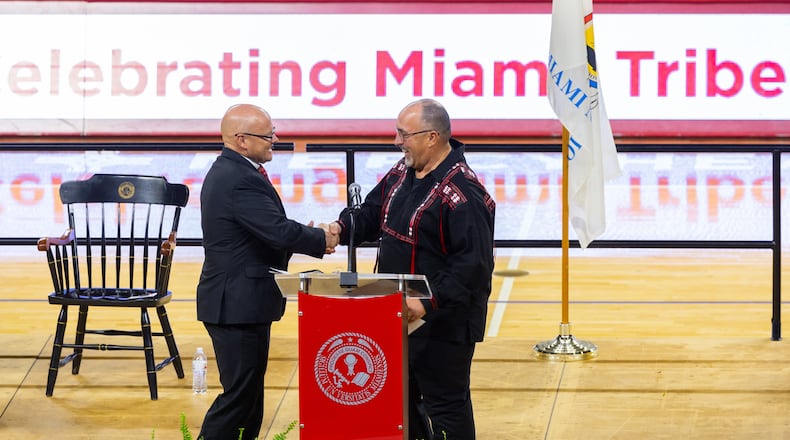The connection began in 1972, when tribal chief Forest Olds traveled to Oxford, eventually met Miami University President Philip Shriver, and forged a relationship.
In the early 1990s, the tribe applied for and received a grant to try to bolster a sense of tribal identity. The Miami language at that time had no native speakers; all had died. Meanwhile, a tribal member named Daryl Baldwin, raised in Toledo, and working as a carpenter, decided to try to revive both the language and the culture of his people.
Recognizing he needed help, Daryl entered and finished a Master’s program in Linguistics in 1999. Then the tribe approached Miami University, to see it if might help in this effort.
And thus began a long, slow process of development. It helped enormously when Miami University made the decision to eliminate the racist moniker “Redskins” for its athletic teams, and become the Redhawks instead.
The university hired Daryl Baldwin for three years to do what he could. Most administrators viewed this as a goodwill gesture, and assumed he would fail. Undeterred, Daryl went to work. He ran language workshops. He helped tribal members revive long-lost tribal customs. He arranged for more and more tribal youngsters to come to Miami University – with full tuition scholarships. And it all worked. Gradually, the Myaamia Center, using the old tribal name, grew. And then, out of the blue, in recognition of his extraordinary efforts, and their success, Daryl was awarded a Macarthur Foundation genius award, one of our nation’s highest honors, which put his efforts on the map. With the Macarthur recognition, the university realized what a good thing it had helped nurture. Increased support was forthcoming. And today, there are 44 tribal students at Miami University, taking a special class on their own culture and language as part of their program, and the Myaamia Center is flourishing as never before.
The winter celebration my wife Sara and I attended was a festive affair.
Highlights included story-telling, by a half-dozen tribal members, with children listening in the front of the room, and the rest of us listening behind them in rapt silence.
But the culmination of the program was the Stomp Dance, a tribal tradition, in which hundreds of us walked with rhythmic steps in a long circular line around a fire – in this case an artificial one made from colored lights – to the sound of elders chanting, and drummers setting the beat.
It was a glorious weekend. There was a sense of good cheer. There was a feeling of family, promoted in part by the fact that many tribal members were, in fact, related in some way to one another. But that festive family sense spread more widely, and made us feel part of a special tradition that we valued, and wanted to keep as part of our lives.
Allan M. Winkler is Distinguished Professor of History Emeritus at Miami University.
About the Author


